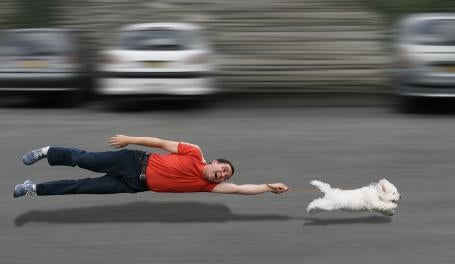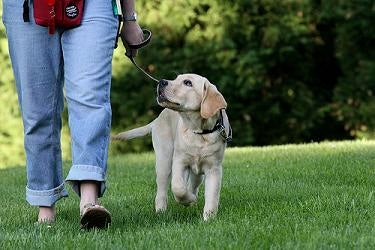Leash Training A Dog - For Puppies & Older Dogs
Training your dog to stop pulling on the leash is one of the most frustrating and common training issues us dog owners are faced with. In reality leash training a dog isn't all that difficult. What it does require is an effective plan, absolute consistency in applying the plan, heaps of practice and a dash of patience. A proven step by step plan is clearly outlined below - all you have to do is add those other elements...
Do you ever wonder how it is that some dogs seem to just happily stroll alongside their owners on a nice loose leash, regardless of what is going on around them? And then there are the dogs who rip, tug and pull their owners the entire time - why is this the case?

[google_ad:DOTR_CMS_468x60_InArticle1]
Leash Training A Dog - Why Do Dogs Pull When On The Leash?
- Pulling is a natural behavior for dogs. When a dog is restrained or pulled back by something, its first and natural response is to pull the other way against it.
- They get "rewarded" for pulling on the leash. The reward is in the form of you walking along more quickly behind them or if they find something interesting out in front like a squashed bug on the pavement - their pulling behavior is being reinforced every time this occurs.
- Many dogs pull because they don't know any different. They have never been clearly shown that pulling on the leash is an unacceptable behavior.
General Rules For Preventing Leash Pulling
- The earlier you start leash training a dog the better. Starting early ensures that you create good behavior habits in your puppy and prevent leash pulling from ever becoming a problem. It's never too late to start your leash training though, it will just take a little more time if your dog has an existing leash pulling problem.
- Never ever reward your dog's leash pulling behavior. This means that the pulling never gets your dog to where he is pulling you towards.
- Always be consistent when leash training a dog. Make it a simple decision for your dog to make - if he pulls on the leash he gets nowhere, if the leash is nice and loose he gets his walkies. Each person who walks your dog must follow and enforce the same leash training rules.
- Put the majority of your focus into showing your dog the behavior you want (lovely loose leash hanging down between the two of you) rather than continually punishing undesirable behavior. Educate and then reinforce appropriate leash walking - make it a more attractive option to your dog than pulling on the leash.

Leash Training A Dog - Proven Step by Step Method
Below is a very simple step by step process to ensure your dog behaves appropriately on leash. I have had plenty of success using this method, so I am confident enough to say that if you follow it closely you will achieve the desired result.This leash training a dog method relies on the theory that a dog's behavior is determined by the immediate consequences of his/her actions.
When leash training this means that your dog quickly comes to the realization that when they pull on the leash they get nowhere. If this continues to happen every time they pull, your dog is highly unlikely to continue to do it - they don't like the consequences of the leash pulling. Especially when they catch on that by sticking close to you on a loose leash they can stroll along happily all they want. Let's get started:
| 1. With your puppy or older dog on leash (I prefer a 6 foot leash) start to walk forward. As soon as your dog straightens the leash out (starts to pull) immediately say "Ah-Ah!" and at the same time stop where you are and don't move. |
| 2. Your dog may be a little surprised by this and wonder what you are up to. He (or she) may lean into the leash even harder, he could lay down or could look back up at you with a quizzical look. |
| 3. When you are stopped if at any stage your dog looks up at you or slackens off the leash immediately praise him and you can also give a tasty treat. If the leash still has some slack in it after your praise and treat this is your cue to recommence the walk. |
| 4. If you are walking along for even 3 or 4 steps without your dog pulling on the leash, you should encourage your dog (good boy!) and give a small tasty treat. But as soon as the leash tightens up again, you guessed it, say "Ah-Ah!" and don't take another step. |
| 5. By following these steps every time you are out on a walk you are communicating two clear messages to your dog:
1. If the leash is tight, I don't get anywhere. 2. If the leash is loose I get to walk, I get lovely praise from my owner, and sometimes I even get a treat as well! In other words you are making it an easy choice for your dog. |
| 6. There is no set time frame for this leash training a dog process to work. It will depend on how early you get started with a young puppy or how deeply entrenched the pulling habit is. If you are seeing gradual progress each time you go for a walk, you are on the right track - keep it up! |
has to say about leash training your dog.
If you plan to leash train your puppy or older dog at home you can learn how to do it the right way in this comprehensive dog training resource. This membership package will also clearly show you how to prevent other problem behaviors and teach all the basic obedience training commands such as sit, stay, come, down, fetch etc...
Please consult the services of a Professional Dog Trainer, Behaviorist or Veterinarian before implementing any of the advice contained on this site.










 Your Privacy Choices
Your Privacy Choices